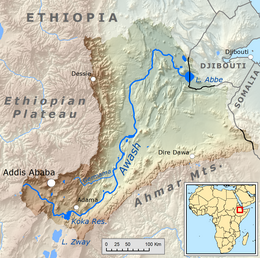Awash River
| UNESCO World Heritage Site | |
|---|---|
 Map of the Awash drainage basin | |
| Location | Ethiopia |
| Criteria | Cultural: (ii)(iii)(iv) |
| Reference | 10 |
| Inscription | 1980 (4th Session) |
The Awash (sometimes spelled Awaash;
The Awash Valley (and especially the
Overview
The Awash rises south of
According to materials published by the Ethiopian
Other tributaries of the Awash include (in order upstream): the Logiya, Mille, Borkana, Ataye, Hawadi, Kabenna and Durkham Rivers. Towns and cities along its course include Metehara, Awash, Gewane and Asaita.
Paleontology
Humans have lived in the valley of the Awash almost since the beginning of the species. Numerous pre-human
History

The valley of the Awash from about 9° N downstream is the traditional home of the Afar people and Issa people.[5] The valley of the Awash have been included as part of the Fatagar, Ifat, and Shewa.[6]
According to Huntingford, in the 16th century the Awash river was called the great Dir river and lay in the country of the Muslims.[7]

The first European to trace the course of the Awash to its end in the
In 1960, the Koka Dam was completed across the Awash River at a point around 75 kilometres (47 mi) from Addis Ababa. With its opening, it became a major source of
The Awash International Bank is named for the Awash River.[9]
Climate
The climate of the Awash River Basin is mostly influenced by the movement of the intertropical convergence zone (ITCZ). During its movement northwards in March/April and its retreat southwards, ITCZ creates two rainy seasons, a shorter one around March ('Belg'), and a longer one between June and September ('Kiremt'), which partly fall into one longer rainy season. The rain-season tends to be bimodal towards eastern Ethiopia and almost unimodal towards western Ethiopia. The time between October and March is a dry season, called 'Bega'.[10] Semi-arid to arid conditions prevail in the Rift Valley. In contrast, the highlands partly receive more than 1,600 millimetres (63 in) of rainfall in ca. six months per year.[11]
Hydrology
Groundwater recharge varies between values exceeding 350 millimetres (14 in) per year in the upper highlands and no recharge at the bottom of the rift valley.[11][12] Groundwater is predominantly recharged at the escarpments and highlands above 1900 m a.s.l.,[13] where annual rainfall is higher than 1,000 millimetres (39 in).[12] Localized small-scale recharge is also supposed to occur at the flanks of the rift valley volcanoes.[13] Artificial groundwater recharge takes further place at irrigated plantations at the rift valley.[13] Recharge from river channel losses and via infiltration from lakes plays a role in the Main Ethiopian Rift (MER) and in southern Afar.[12]
Ecology
Most of the Awash Basin is part of the Ethiopian montane forests ecoregion. At high altitudes the Ethiopian montane grasslands and woodlands and Ethiopian montane moorlands predominate. The Somali Acacia–Commiphora bushlands and thickets ecoregion occupies low elevations in the Rift.[14]
The basin's vegetation has a strong anthropogenic impact.
Fauna
The lower Awash valley is one of the last wildlife preserves for the
See also
- List of rivers of Ethiopia
- List of fossil sites (with link directory)
- List of hominina (hominid) fossils(with images)
- List of World Heritage Sites in Ethiopia
References
- ^ a b c d "Lower Valley of the Awash". UNESCO World Heritage Site. United Nations Educational, Scientific, and Cultural Organization. Retrieved 18 September 2021.
- ^ "Climate, 2008 National Statistics (Abstract)" Archived 2010-11-13 at the Wayback Machine, Table A.1. Central Statistical Agency website (accessed 26 December 2009)
- ^ One or more of the preceding sentences incorporates text from a publication now in the public domain: Chisholm, Hugh, ed. (1911). "Abyssinia". Encyclopædia Britannica. Vol. 1 (11th ed.). Cambridge University Press. p. 84.
- ^ S2CID 4432082.
- S2CID 153511308.
- ^ Richard Pankhurst, The Ethiopian Borderlands (Lawrenceville: Red Sea Press, 1997), p. 61
- ISBN 978-0-9723172-6-9.
- ^ As related in his memoirs, Hell-Hole of Creation: The Exploration of Abyssinian Danakil (New York: Alfred A. Knopf, 1935)
- ^ "assessment of credit risk management policies" (PDF). 1 November 2022.
- ISSN 1097-0088.
- ^ .
- ^ .
- ^ .
- ^ "The ecozones of the world. The ecological division of the geosphere". ResearchGate. Retrieved 2017-10-21.
- ^ a b Knoche, M. (2011): Hydrological Modelling of the Upper Awash Catchment (Main Ethiopian Rift). Master thesis, Technische Universität Freiberg, 2011, Freiberg, Germany
- ISSN 1096-9837.
- ^ Moehlman, P.D., Yohannes, H., Teclai, R. & Kebede, F. 2008. Equus Africanus. In: IUCN 2011. IUCN Red List of Threatened Species. Version 2011.1. <www.iucnredlist.org>. Downloaded on 28 September 2011.
External links
 Media related to Awash River at Wikimedia Commons
Media related to Awash River at Wikimedia Commons- The Middle Awash Project website
Further reading
- Zewdu Tememew Molla, "Dam Safety Evaluation on Koka Dam, Ethiopia". M.Sc. thesis, 2005. abstract
This article incorporates text from a publication now in the public domain: Chisholm, Hugh, ed. (1911). "Abyssinia". Encyclopædia Britannica (11th ed.). Cambridge University Press. 11°06′00″N 40°34′46″E / 11.10000°N 40.57944°E
